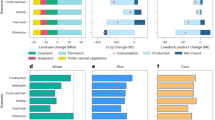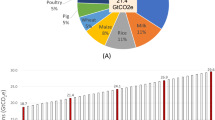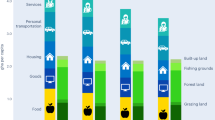Abstract
Degrowth proponents advocate reducing ecologically destructive forms of production and resource throughput in wealthy economies to achieve environmental goals, while transforming production to focus on human well-being. Here we present a quantitative model to test degrowth principles in the food and land system. Our results confirm that reducing and redistributing income alone, within current development paradigms, leads to limited greenhouse gas (GHG) emission mitigation from agriculture and land-use change, as the nutrition transition towards unsustainable diets already occurs at relatively low income levels. Instead, we show that a structural, qualitative food system transformation can achieve a steady-state food system economy that is net GHG-neutral by 2100 while improving nutritional outcomes. This sustainable transformation reduces material throughput via a convergence towards a needs-based food system, is enabled by a more equitable income distribution and includes efficient resource allocation through the pricing of GHG emissions as a complementary strategy. It thereby integrates degrowth and efficiency perspectives.
This is a preview of subscription content, access via your institution
Access options
Access Nature and 54 other Nature Portfolio journals
Get Nature+, our best-value online-access subscription
$29.99 / 30 days
cancel any time
Subscribe to this journal
Receive 12 digital issues and online access to articles
$119.00 per year
only $9.92 per issue
Buy this article
- Purchase on Springer Link
- Instant access to full article PDF
Prices may be subject to local taxes which are calculated during checkout

Similar content being viewed by others
Data availability
Generated data and replication scripts have been archived at: https://doi.org/10.5281/zenodo.5543427
Code availability
MAgPIE is an open-source model available at: https://github.com/magpiemodel/magpie. The model documentation for the exact version of MAgPIE used in this study (v.4.3.4) can be found at https://rse.pik-potsdam.de/doc/magpie/4.3.4/.
References
Schneider, F., Kallis, G. & Martinez-Alier, J. Crisis or opportunity? Economic degrowth for social equity and ecological sustainability. Introduction to this special issue. J. Clean. Prod. 18, 511–518 (2010).
Rockström, J. et al. A safe operating space for humanity. Nature 461, 472–475 (2009).
Hickel, J. et al. Urgent need for post-growth climate mitigation scenarios. Nat. Energy 6, 766–768 (2021).
Hickel, J. What does degrowth mean? A few points of clarification. Globalizations 18, 1105–1111 (2021).
Xue, J., Arler, F. & Næss, P. Is the degrowth debate relevant to China? Environ. Dev. Sustain 14, 85–109 (2012).
Victor, P. A. Growth, degrowth and climate change: a scenario analysis. Ecol. Econ. 84, 206–212 (2012).
Kallis, G. et al. Research on degrowth. Annu. Rev. Environ. Resour. 43, 291–316 (2018).
D’Alisa, G., Demaria, F. & Kallis, G. Degrowth: A Vocabulary for a New Era (Routledge, 2014).
Otero, I. et al. Biodiversity policy beyond economic growth. Conserv. Lett. 13, e12713 (2020).
Keyßer, L. T. & Lenzen, M. 1.5 °C degrowth scenarios suggest the need for new mitigation pathways. Nat. Commun. 12, 2676 (2021).
Nieto, J., Carpintero, Ó., Miguel, L. J. & de Blas, I. Macroeconomic modelling under energy constraints: global low carbon transition scenarios. Energy Policy 137, 111090 (2020).
Global assessment report on biodiversity and ecosystem services of the Intergovernmental Science-Policy Platform on Biodiversity and Ecosystem Services (IPBES, 2019); https://doi.org/10.5281/zenodo.3831674
Rockström, J., Edenhofer, O., Gaertner, J. & DeClerck, F. Planet-proofing the global food system. Nat. Food 1, 3–5 (2020).
Crippa, M. et al. Food systems are responsible for a third of global anthropogenic GHG emissions. Nat. Food 2, 198–209 (2021).
Clark, M. A. et al. Global food system emissions could preclude achieving the 1.5° and 2 °C climate change targets. Science 370, 705–708 (2020).
Cosme, I., Santos, R. & O’Neill, D. W. Assessing the degrowth discourse: a review and analysis of academic degrowth policy proposals. J. Clean. Prod. 149, 321–334 (2017).
Daly, H. E. Allocation, distribution, and scale: towards an economics that is efficient, just, and sustainable. Ecol. Econ. 6, 185–193 (1992).
Dietrich, J. P. et al. MAgPIE 4—a modular open-source framework for modeling global land systems. Geosci. Model Dev. 12, 1299–1317 (2019).
Leclère, D. et al. Bending the curve of terrestrial biodiversity needs an integrated strategy. Nature 585, 551–556 (2020).
Bodirsky, B. L. et al. Reactive nitrogen requirements to feed the world in 2050 and potential to mitigate nitrogen pollution. Nat. Commun. 5, 3858 (2014).
Springmann, M. et al. Options for keeping the food system within environmental limits. Nature 562, 519–525 (2018).
Soergel, B. et al. A sustainable development pathway for climate action within the UN 2030 Agenda. Nat. Clim. Change 11, 656–664 (2021).
Bodirsky, B. L. et al. The ongoing nutrition transition thwarts long-term targets for food security, public health and environmental protection. Sci Rep. 10, 19778 (2020).
Stevanović, M. et al. The impact of high-end climate change on agricultural welfare. Sci. Adv. 2, e1501452 (2016).
Masters, W. A. et al. The nutrition transition and agricultural transformation: a Preston curve approach. Agric. Econ. 47, 97–114 (2016).
Hubacek, K., Baiocchi, G., Feng, K. & Patwardhan, A. Poverty eradication in a carbon constrained world. Nat. Commun. 8, 912 (2017).
Popkin, B. M., Corvalan, C. & Grummer-Strawn, L. M. Dynamics of the double burden of malnutrition and the changing nutrition reality. Lancet 395, 65–74 (2020).
Springmann, M., Godfray, H. C. J., Rayner, M. & Scarborough, P. Analysis and valuation of the health and climate change cobenefits of dietary change. Proc. Natl Acad. Sci. USA 113, 4146–4151 (2016).
Riahi, K. et al. The Shared Socioeconomic Pathways and their energy, land use, and greenhouse gas emissions implications: an overview. Glob. Environ. Change 42, 153–168 (2017).
Jakob, M., Lamb, W. F., Steckel, J. C., Flachsland, C. & Edenhofer, O. Understanding different perspectives on economic growth and climate policy. WIREs Clim. Change 11, e677 (2020).
Daly, H. Ecological Economics and Sustainable Development: Selected Essays (Edward Elgar, 2008).
Tubb, C. & Seba, T. Rethinking food and agriculture 2020–2030: the second domestication of plants and animals, the disruption of the cow, and the collapse of industrial livestock farming. Ind. Biotechnol. 17, 57––72 (2021).
Yi, J. et al. Post-farmgate food value chains make up most of consumer food expenditures globally. Nat. Food 2, 417–425 (2021).
Latka, C. et al. Paying the price for environmentally sustainable and healthy EU diets. Glob. Food Secur 28, 100437 (2021).
O’Neill, D. W. Measuring progress in the degrowth transition to a steady state economy. Ecol. Econ. 84, 221–231 (2012).
Willett, W. et al. Food in the Anthropocene: the EAT–Lancet Commission on healthy diets from sustainable food systems. Lancet 393, 447–492 (2019).
Hawkes, C. et al. Smart food policies for obesity prevention. Lancet 385, 2410–2421 (2015).
Swinburn, B. et al. Monitoring and benchmarking government policies and actions to improve the healthiness of food environments: a proposed Government Healthy Food Environment Policy Index. Obes. Rev. 14, 24–37 (2013).
Campos, S., Doxey, J. & Hammond, D. Nutrition labels on pre-packaged foods: a systematic review. Public Health Nutr. 14, 1496–1506 (2011).
Magnus, A., Haby, M. M., Carter, R. & Swinburn, B. The cost-effectiveness of removing television advertising of high-fat and/or high-sugar food and beverages to Australian children. Int. J. Obes. 2005 33, 1094–1102 (2009).
Girard, A. W. & Olude, O. Nutrition education and counselling provided during pregnancy: effects on maternal, neonatal and child health outcomes. Paediatr. Perinat. Epidemiol. 26, 191–204 (2012).
Cook, S. L., Nasser, R., Comfort, B. L. Webster & Larsen, D. K. Effect of nutrition counselling on client perceptions and eating behaviour. Can. J. Diet. Pract. Res. 67, 171–177 (2006).
Taber, D. R., Chriqui, J. F., Powell, L. & Chaloupka, F. J. Association between state laws governing school meal nutrition content and student weight status: implications for new USDA school meal standards. JAMA Pediatr. 167, 513–519 (2013).
Allais, O. & Nichèle, V. Capturing structural changes in French meat and fish demand over the period 1991–2002. Eur. Rev. Agric. Econ. 34, 517–538 (2007).
Witt, U. in Demand, Complexity, and Long-run Economic Evolution (eds Chai, A. & Baum, C. M.) 117–139 (Springer, 2019); https://doi.org/10.1007/978-3-030-02423-9_7
Fankhauser, S., Tol, R. S. J. & Pearce, D. W. The aggregation of climate change damages: a welfare theoretic approach. Environ. Resour. Econ 10, 249–266 (1997).
OECD Guidelines on Measuring Subjective Well-being (OECD, 2013).
Hirvonen, K., Bai, Y., Headey, D. & Masters, W. A. Affordability of the EAT–Lancet reference diet: a global analysis. Lancet Glob. Health 8, e59–e66 (2020).
Soergel, B. et al. Combining ambitious climate policies with efforts to eradicate poverty. Nat. Commun. 12, 2342 (2021).
Murray, B. & Rivers, N. British Columbia’s revenue-neutral carbon tax: a review of the latest ‘grand experiment’ in environmental policy. Energy Policy 86, 674–683 (2015).
Pacheco, F. A. L., Sanches Fernandes, L. F., Valle Junior, R. F., Valera, C. A. & Pissarra, T. C. T. Land degradation: multiple environmental consequences and routes to neutrality. Curr. Opin. Environ. Sci. Health 5, 79–86 (2018).
World Social Report 2020: Inequality in a Rapidly Changing World (UN, 2020); https://doi.org/10.18356/7f5d0efc-en
Bauer, N. et al. Shared Socio-Economic Pathways of the energy sector—quantifying the narratives. Glob. Environ. Change 42, 316–330 (2017).
Gerten, D. et al. Feeding ten billion people is possible within four terrestrial planetary boundaries. Nat. Sustain 3, 200–208 (2020).
Gaupp, F. et al. Food system development pathways for healthy, nature-positive and inclusive food systems. Nat. Food 2, 928–934 (2021).
Gustavsson, J., Cederberg, C. & Sonesson, U. Global Food Losses and Food Waste: Extent, Causes and Prevention. Study Conducted for the International Congress Save Food! at Interpack 2011, Düsseldorf, Germany (FAO, 2011).
Weindl, I. et al. Livestock and human use of land: productivity trends and dietary choices as drivers of future land and carbon dynamics. Glob. Planet. Change 159, 1–10 (2017).
Wang, X. et al. Beyond land-use intensity: assessing future global crop productivity growth under different socioeconomic pathways. Technol. Forecast. Soc. Change 160, 120208 (2020).
Dietrich, J. P., Schmitz, C., Lotze-Campen, H., Popp, A. & Müller, C. Forecasting technological change in agriculture—an endogenous implementation in a global land use model. Technol. Forecast. Soc. Change 81, 236–249 (2014).
Pikaar, I. et al. Decoupling livestock from land use through industrial feed production pathways. Environ. Sci. Technol. 52, 7351–7359 (2018).
Schmitz, C. et al. Agricultural trade and tropical deforestation: interactions and related policy options. Reg. Environ. Change 15, 1757–1772 (2015).
Popp, A. et al. Land-use transition for bioenergy and climate stabilization: model comparison of drivers, impacts and interactions with other land use based mitigation options. Clim. Change 123, 495–509 (2014).
Strefler, J. et al. Carbon dioxide removal technologies are not born equal. Environ. Res. Lett. 16, 074021 (2021).
Hurtt, G. C. et al. Harmonization of global land use change and management for the period 850–2100 (LUH2) for CMIP6. Geosci. Model Dev. 13, 5425–5464 (2020).
Windisch, M. G., Davin, E. L. & Seneviratne, S. I. Prioritizing forestation based on biogeochemical and local biogeophysical impacts. Nat. Clim. Change 11, 867–871 (2021).
Kreidenweis, U. et al. Afforestation to mitigate climate change: impacts on food prices under consideration of albedo effects. Environ. Res. Lett. 11, 085001 (2016).
Windisch, M. G. et al. Accounting for local temperature effect substantially alters afforestation patterns. Environ. Res. Lett. 17, 024030 (2022).
IPCC Guidelines for National Greenhouse Gas Inventories (IPCC, 2006); https://www.ipcc.ch/report/2006-ipcc-guidelines-for-national-greenhouse-gas-inventories/
Lucas, P. L., van Vuuren, D. P., Olivier, J. G. J. & den Elzen, M. G. J. Long-term reduction potential of non-CO2 greenhouse gases. Environ. Sci. Policy 10, 85–103 (2007).
Popp, A. et al. Land-use futures in the shared socio-economic pathways. Glob. Environ. Change 42, 331–345 (2017).
The World Bank Group A to Z 2016 83b–83b, ‘High-Income Countries’ (World Bank, 2015); https://doi.org/10.1596/978-1-4648-0484-7_high_income_countries
Jackson, T. Prosperity without Growth: Foundations for the Economy of Tomorrow (Routledge, 2016).
Kubiszewski, I. & Costanza, R. in The Sustainability Practitioner’s Guide to Social Analysis and Assessment (eds Murray, J., McBain, D. & Wiedmann, T.) 44–51 (Common Ground Publishing, 2015).
Kriegler, E. et al. Fossil-fueled development (SSP5): an energy and resource intensive scenario for the 21st century. Glob. Environ. Change 42, 297–315 (2017).
Luderer, G. et al. Description of the REMIND Model (Version 1.6) https://doi.org/10.2139/ssrn.2697070 (2015).
Hickel, J. The sustainable development index: measuring the ecological efficiency of human development in the anthropocene. Ecol. Econ. 167, 106331 (2020).
Alexander, S. Planned economic contraction: the emerging case for degrowth. Environ. Polit. 21, 349–368 (2012).
Infante Amate, J. & González de Molina, M. ‘Sustainable de-growth’ in agriculture and food: an agro-ecological perspective on Spain’s agri-food system (year 2000). J. Clean. Prod. 38, 27–35 (2013).
Acknowledgements
D.M.-C.C. and F.B. are supported by the Deutsche Bundesstiftung Umwelt (DBU). B.L.B. has received funding from the European Union’s Horizon 2020 research and innovation programme under grant agreement numbers 776479 (COACCH), 689150 (SIM4NEXUS) and 821010 (CASCADES) and from the Norwegian Research Council (Greenplantfoods). E.J.M.B. acknowledges support from FABLE 2.0 grant agreement number 94120, which is funded by FOLU grant agreement number 94120. F.B. and F.G. receive funding from the Food System Economics Commission, which is funded by the Rockefeller Foundation (2020FOD008) and the Wellcome Trust (221362/Z/20/Z). SHAPE is part of AXIS, an ERA-NET initiated by JPI Climate, and funded by FORMAS (Sweden), FFG/BMWFW (Austria), DLR/BMBF (Germany, grant number 01LS19XXY), NWO (Netherlands) and RCN (Norway) with co-funding by the European Union (grant number 776608). Funding from the German Federal Ministry of Education and Research (BMBF) in the context of the project ‘FOCUS—food security and sustained coastal livelihoods through linking land and ocean’ (031B0787B) is gratefully acknowledged. Further support is provided by the Global Commons Stewardship (GCS) project, funded by the University of Tokyo.
Author information
Authors and Affiliations
Contributions
B.L.B. and D.M.-C.C. designed the study and drafted the manuscript. B.L.B., D.M.-C.C., I.W., E.J.M.B. and H.L.-C. contributed to core model development. D.M.-C.C. undertook the modelling and analysis. All authors contributed to discussing the results and writing the paper.
Corresponding author
Ethics declarations
Competing interests
The authors declare no competing interests.
Peer review
Peer review information
Nature Food thanks Manfred Lenzen and the other, anonymous, reviewer(s) for their contribution to the peer review of this work.
Additional information
Publisher’s note Springer Nature remains neutral with regard to jurisdictional claims in published maps and institutional affiliations.
Supplementary information
Supplementary Information
Supplementary Text 1 and 2, Table 1 and Figs. 1–4.
Supplementary Data
Detailed model outputs and indicators across scenarios and years.
Rights and permissions
About this article
Cite this article
Bodirsky, B.L., Chen, D.MC., Weindl, I. et al. Integrating degrowth and efficiency perspectives enables an emission-neutral food system by 2100. Nat Food 3, 341–348 (2022). https://doi.org/10.1038/s43016-022-00500-3
Received:
Accepted:
Published:
Issue Date:
DOI: https://doi.org/10.1038/s43016-022-00500-3
This article is cited by
-
Building climate resilience, social sustainability and equity in global fisheries
npj Ocean Sustainability (2023)
-
Compensation for atmospheric appropriation
Nature Sustainability (2023)
-
Supply chain disruptions would increase agricultural greenhouse gas emissions
Regional Environmental Change (2023)
-
An instrumental value-based framework for assessing the damages of abiotic resources use in life cycle assessment
The International Journal of Life Cycle Assessment (2023)
-
Uncertainty in land-use adaptation persists despite crop model projections showing lower impacts under high warming
Communications Earth & Environment (2023)



